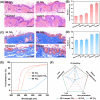Two-Dimensional TiO2 Ultraviolet Filters for Sunscreens
- PMID: 40526263
- PMCID: PMC12173993
- DOI: 10.1007/s40820-025-01805-1
Two-Dimensional TiO2 Ultraviolet Filters for Sunscreens
Abstract
Titanium dioxide (TiO2) has been an important protective ingredient in mineral-based sunscreens since the 1990s. However, traditional TiO2 nanoparticle formulations have seen little improvement over the past decades and continue to face persistent challenges related to light transmission, biosafety, and visual appearance. Here, we report the discovery of two-dimensional (2D) TiO2, characterized by a micro-sized lateral dimension (~1.6 μm) and atomic-scale thickness, which fundamentally resolves these long-standing issues. The 2D structure enables exceptional light management, achieving 80% visible light transparency-rendering it nearly invisible on the skin-while maintaining UV-blocking performance comparable to unmodified rutile TiO2 nanoparticles. Its larger lateral size results in a two-orders-of-magnitude reduction in skin penetration (0.96 w/w%), significantly enhancing biosafety. Moreover, the unique layered architecture inherently suppresses the generation of reactive oxygen species (ROS) under sunlight exposure, reducing the ROS generation rate by 50-fold compared to traditional TiO2 nanoparticles. Through precise metal element modulation, we further developed the first customizable sunscreen material capable of tuning UV protection ranges and automatically matching diverse skin tones. The 2D TiO2 offers a potentially transformative approach to modern sunscreen formulation, combining superior UV protection, enhanced safety and a natural appearance.
Keywords: Biosafety; Sunscreen; Titanium dioxide; Two-dimensional.
© 2025. The Author(s).
Conflict of interest statement
Declarations. Conflict of interests: The authors declare no conflict of interest. They have no known competing financial interests or personal relationships that could have appeared to influence the work reported in this paper.
Figures






Similar articles
-
The Black Book of Psychotropic Dosing and Monitoring.Psychopharmacol Bull. 2024 Jul 8;54(3):8-59. Psychopharmacol Bull. 2024. PMID: 38993656 Free PMC article. Review.
-
Sun protection for preventing basal cell and squamous cell skin cancers.Cochrane Database Syst Rev. 2016 Jul 25;7(7):CD011161. doi: 10.1002/14651858.CD011161.pub2. Cochrane Database Syst Rev. 2016. PMID: 27455163 Free PMC article.
-
Uncovering the efficacy of a natural homemade sunscreen in protection from ultraviolet radiation.Photochem Photobiol Sci. 2025 Jun;24(6):1017-1029. doi: 10.1007/s43630-025-00742-7. Epub 2025 Jun 7. Photochem Photobiol Sci. 2025. PMID: 40481984
-
A review on tailoring lignin derivatives for sunscreen formulations: Structural modification and antioxidant properties for enhanced UV protection.Int J Biol Macromol. 2025 Jul;318(Pt 1):144871. doi: 10.1016/j.ijbiomac.2025.144871. Epub 2025 Jun 1. Int J Biol Macromol. 2025. PMID: 40460953 Review.
-
Management of urinary stones by experts in stone disease (ESD 2025).Arch Ital Urol Androl. 2025 Jun 30;97(2):14085. doi: 10.4081/aiua.2025.14085. Epub 2025 Jun 30. Arch Ital Urol Androl. 2025. PMID: 40583613 Review.
References
-
- H. Sung, J. Ferlay, R.L. Siegel, M. Laversanne, I. Soerjomataram et al., Global cancer statistics 2020: GLOBOCAN estimates of incidence and mortality worldwide for 36 cancers in 185 countries. CA Cancer J. Clin. 71(3), 209–249 (2021). 10.3322/caac.21660 - PubMed
-
- A.S. Aldahan, V.V. Shah, S. Mlacker, K. Nouri, The history of sunscreen. JAMA Dermatol. 151(12), 1316 (2015). 10.1001/jamadermatol.2015.3011 - PubMed
-
- Y. Ma, J. Yoo, History of sunscreen: an updated view. J. Cosmet. Dermatol. 20(4), 1044–1049 (2021). 10.1111/jocd.14004 - PubMed
-
- D.L. Giokas, A. Salvador, A. Chisvert, UV filters: from sunscreens to human body and the environment. TrAC Trends Anal. Chem. 26(5), 360–374 (2007). 10.1016/j.trac.2007.02.012
LinkOut - more resources
Full Text Sources
Miscellaneous
